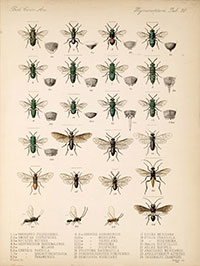 Cameron, in his fabulous work 'Biologia Centrali-Americana' from the years 1883 to 1900, published a first catalog of bees and wasps from Central America with 1.826 valid species and 114 synonyms. Most of these records were from Mexico, Panama, Guatemala and Costa Rica. Nowadays about 10 times more species are known from this area of the world. In our database by now about 27.400 valid species/subspecies and more than 9.000 synonyms are listed from Central America (eXtended), within the 4th and the 30th degree of latitude. In total the database contains more than 41.000 name combinations.
Cameron, in his fabulous work 'Biologia Centrali-Americana' from the years 1883 to 1900, published a first catalog of bees and wasps from Central America with 1.826 valid species and 114 synonyms. Most of these records were from Mexico, Panama, Guatemala and Costa Rica. Nowadays about 10 times more species are known from this area of the world. In our database by now about 27.400 valid species/subspecies and more than 9.000 synonyms are listed from Central America (eXtended), within the 4th and the 30th degree of latitude. In total the database contains more than 41.000 name combinations.
Cameron listed from Mexico 1208 species, from Panama 411 species, from Guatemala 362 species and from Costa Rica 119 species. In total he published from more than 40 Countries records of bees and wasps and the species belong to 41 families. The five families with the highest diversity are the Ichneumonidae (540), Mutillidae (216), Crabronidae (203), Braconidae (176), Pompilidae (168). For this time it was a comprehensive list of species.
Now the most species rich families are Formicidae (3236), Braconidae (3504), Ichneumonidae (3206), Apidae (1768), Eulophidae (1449), Crabronidae (1490), and Pompilidae with 919 species. These families belong to the four superfamilies Apoidea, Chalcidoidea, Ichneumonoidea and Vespoidea. Still, Mexico, Costa Rica, Panama and Guatemala belong to the countries that have the highest diversity of species. This may be due to the size of the countries, but also probable to the higher number of scientific investigations in these countries. Looking at countries in the eXtended geographic range of Central America, Texas and Florida in the north and Colombia in the south belong to the countries with the highest species diversity. From the Caribbean Islands Cuba and Trinidad and Tobago are the countries with the highest diversity, each of them with almost 1200 species. But we still have to take in acount that the database is inclomplete.
Objectiv:
The objectiv of the project is to create a validated taxonomic backbone of bees and wasps for Central America eXtended that may be used for the assessment of biodiversity, monitoring of changes, discover gaps and for a sustainable exploitation of biodiversity.
